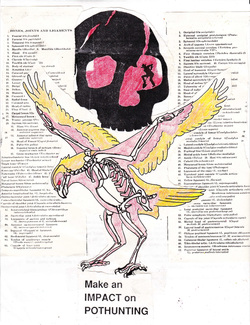
"Feature 3 was an adult female burial which on two occasions, had been disturbed. In 1990 the burial had been cut into by the telephone trench. The northern edge of the burial was disturbed and a number of bones and vessels appear to have been displaced at that time. The burial was struck a second time in 1991 when the backhoe 'trimmed' the west end of the burial pit. The burial pit had been cut deep into the caliche. It was at least 75 to 80 cm below the present ground surface.
The pit was at least 70 cm wide northeast to southwest and 90 cm long northwest to southeast.
The body lay on its right side with the axial skeleton orientated east to west. The skull was at the east end of the pit. The upper arms appear to have been lying along the front of the chest. One forearm was drawn up so that the wrist lay below the humerus. The other lower arm was disarticulated. An in-situ hand lay against the north edge of the pit. The legs were flexed with the knees pointing north. The lower legs were removed by the backhoe. In general the burial was very disarticulated from the two backhoe disturbances and rodent activity. It is possible that when the burial was originally uncovered in 1990, portions of the skeleton may have been disturbed intentionally.
Field observations indicated that this individual was a female, probably aged older than 35 at death..."
"Feature 4 was a child's burial that had been cut by the backhoe and subsequently removed by workers prior to the arrival of the archaeologists. No in-situ bone survived. Most of the skeleton was not recovered. The pit was cut deeply into the caliche. It was round bottomed and was at least at 65 cm long west to east and 30 cm wide north to south. The base of the pit was 97 cm below the current ground surface. Feature 4 was almost directly below Feature 5.
Skeletal portions recovered included the left frontal and temporal, both parietals, the mandible, and the right tibia. No teeth had erupted, suggesting the child was less than a year old at death. Both were recovered as specimen 16."
The pit was at least 70 cm wide northeast to southwest and 90 cm long northwest to southeast.
The body lay on its right side with the axial skeleton orientated east to west. The skull was at the east end of the pit. The upper arms appear to have been lying along the front of the chest. One forearm was drawn up so that the wrist lay below the humerus. The other lower arm was disarticulated. An in-situ hand lay against the north edge of the pit. The legs were flexed with the knees pointing north. The lower legs were removed by the backhoe. In general the burial was very disarticulated from the two backhoe disturbances and rodent activity. It is possible that when the burial was originally uncovered in 1990, portions of the skeleton may have been disturbed intentionally.
Field observations indicated that this individual was a female, probably aged older than 35 at death..."
"Feature 4 was a child's burial that had been cut by the backhoe and subsequently removed by workers prior to the arrival of the archaeologists. No in-situ bone survived. Most of the skeleton was not recovered. The pit was cut deeply into the caliche. It was round bottomed and was at least at 65 cm long west to east and 30 cm wide north to south. The base of the pit was 97 cm below the current ground surface. Feature 4 was almost directly below Feature 5.
Skeletal portions recovered included the left frontal and temporal, both parietals, the mandible, and the right tibia. No teeth had erupted, suggesting the child was less than a year old at death. Both were recovered as specimen 16."
 RSS Feed
RSS Feed